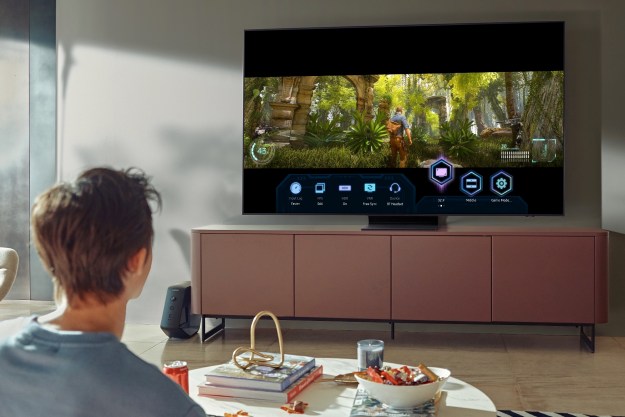It’s not quite a headset, it’s not really a virtual reality system, but if you’re looking for a thrilling way to escape from the outside world, Avegant’s brilliant new multimedia device, the Glyph, may be just what you’ve been after.
It might seem strange to rotate a headset so you’re staring straight into the band, and I’ll admit, the first time I saw someone wearing the Glyph I couldn’t stop thinking of Geordi from Star Trek Next Generation. But it didn’t take long after putting it on to get it. I was hooked.
Inside the somewhat benign-looking band, Avegant has packed in a whole lot of high-quality tech. The Glyph offers no display screen in the traditional sense, trading an LCD or OLED screen for two million tiny mirrors to beam the image into glass lenses. An array of switches and buttons on the band control sound and playback, focus the lenses to your eyes, and adjust the nose bridge to fit. Inputs include a micro HDMI — so you can plug in virtually any media source — and there’s even a 3.5mm headphone jack if you want to use the Glyph as a basic pair of headphones while powered down.
The device is said to offer four hours of playtime per charge, but it can also be plugged in for long flights or simply sitting on your couch, allowing you to keep rocking.
A theater on your head
A strange glow illuminates from the Glyph’s lenses as you put them on that induces just a bit of pause — “Is this thing going to burn my eyeballs out?” But once you strap in and focus the binocular-style lenses for your specific eyesight — which works even without eyeglasses, for fuzzy-eyed folks like me — the Glyph serves up a boast-worthy A/V experience.
My first demo was an extreme sports vid. The Harman-powered 50mm drivers in the ear cups provided a powerful sonic backdrop and the image looked very good — much cleaner than you’d expect from the 720p max resolution. Founder and CSO Ed Tang tells us that’s due to the utter lack of those little RGB pixels you’ll discover once you get close enough to standard displays.
Next, Tang punched up The Avengers in 3D — and things got much more interesting. As I watched Mark Ruffalo become the Hulk in the middle of an NYC melee, the busy buzz of the MWC exhibition halls melted away. Suddenly I was simply enjoying the movie as if I were sitting in the comfort of my living room, or in a real theater — and chuckling a bit to myself at the impressive 3D image coming from this strange contraption.
Like good showmen, however, the Avegant crew left the best for last: mobile gaming. Now, I know I’m in the minority here, but I’ve never been a big fan of playing mobile games. It’s not that I don’t enjoy gaming at all, but the experience of gaming on a tiny screen my fingers will cover half of just feels underwhelming to me. But powered through the Glyph, I could see myself spending a lot of time gaming my life away.
The Glyph is one of the coolest immersive media devices we’ve come across yet, especially considering its utter mobility.
The racing game I tried dropped me onto a racetrack surrounded by a cacophony of roaring engines, crashing metal, and impressive views of a European landscape. I spent so much time trying to muscle my way to the front of the pack that eventually I saw someone from the Avegant team coming to pull me out of it — they had another meeting to attend.
That brings up another cool feature of the Glyph. While it’s easy to feel fully immersed in the movie theater-style experience, you can also see the world around you by simply peeking below the band. That makes it easy to, say, switch up media from your phone, or maybe, as Tang suggested, grab a beer from the drink cart as the flight attendant rolls by. There’s a tendency to move your head a bit while gaming — and in fact, the Glyph does have sensors to track your movement for VR-style applications. But even when I jerked my head around, it didn’t take me out of the experience.
The headset is also surprisingly comfortable, thanks to heavy cushioning on the ear pads. The only real issue I could imaging arising with prolonged use is some pressure on the bridge of the nose, as the Glyph is a bit heavy. However, I’m told there are swappable nose pieces, so it might be that the right fit will alleviate the issue for the most part.
When can I get one, and what’s it gonna cost?
Born on Kickstarter, and funded by millions in its current evolution, the Glyph made its first major appearance at CES last month, and will finally hit the U.S. market in the next few weeks. It will go for $700 — a hefty fee, no doubt. That said, as an audio reviewer, I’ve seen plenty of headphones in the $500 range, and well above. At that point, another $200 for an immersive, TV-like experience seems more reasonable. For frequent travelers, or those simply looking for a way to bring immersive media and gaming anywhere, it may well be worth it.
We’ll be giving the Glyph a long-term test to see if it can live up to its impressive demo — and whether or not that nose-bridge pressure we experienced is going to be a slight annoyance, or an uncomfortable barrier.
For first impressions however, the Glyph is one of the coolest immersive media devices we’ve come across yet, especially considering its utter mobility. You’re also getting both your visual and audio in one purchase — something few competing devices that lean more towards VR offer.
Stay tuned for our full review of the Glyph coming soon, and look for the device to hit the open market in just a couple of weeks.






